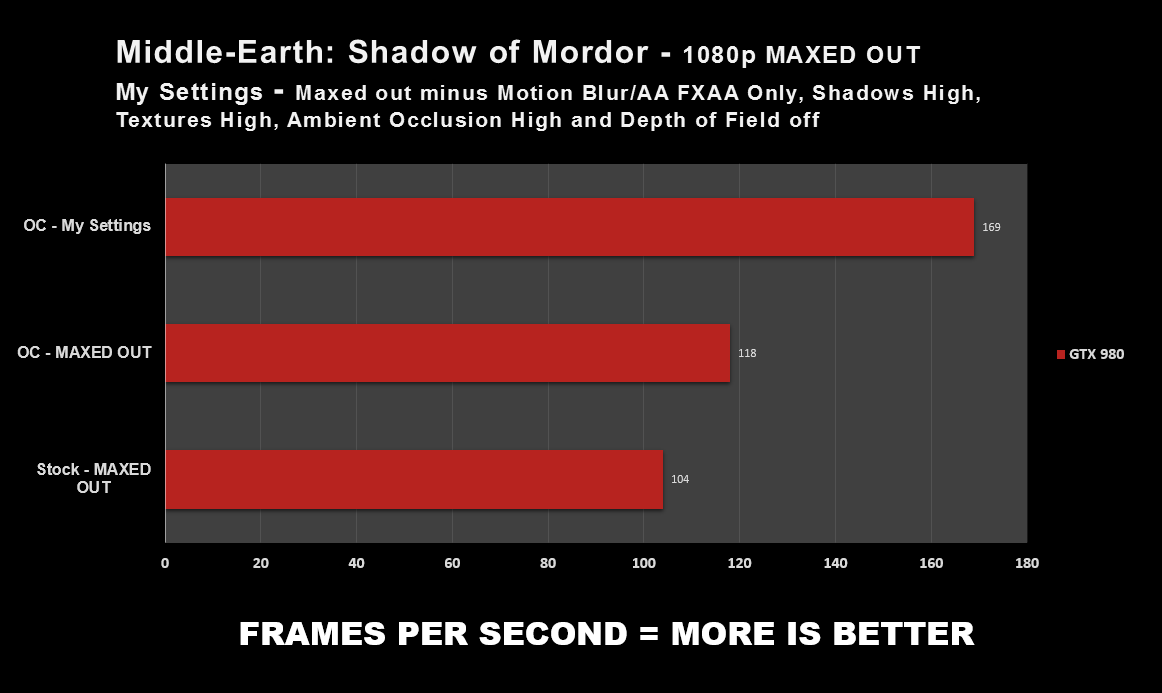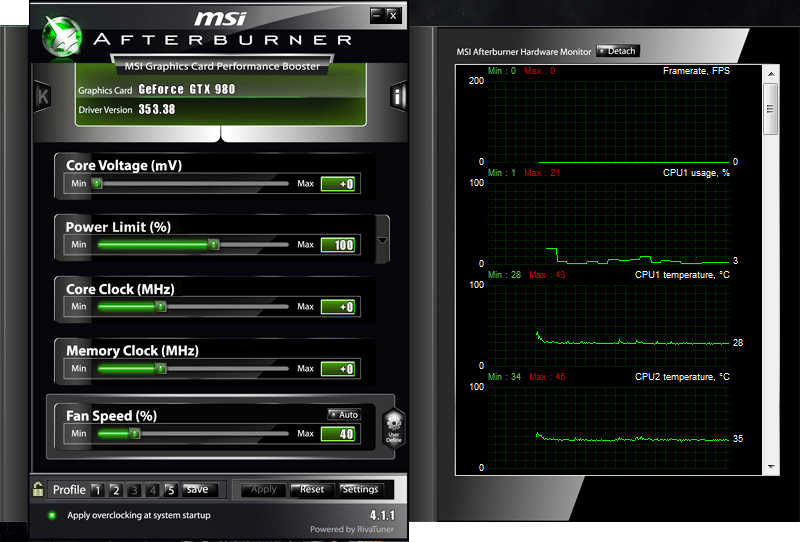INTRO
The sheer size of the ASUS GTX 980 STRIX OC Edition – quite the mouthful – is quite a beastly looking GPU. In short, this card beats most GPUs in its price range (all pricing in this article refers to the Australian prices), apart from something like the almighty lord of rendering, the Nvidia Titan X, of course. To test this card I used only synthetic benchmarks, because they give a reasonable representation of the performance the GPU is capable of outputting. With some games, you may receive a higher frame rate (FPS) within the game itself. At a later date I will also test to see if that statement holds true.
The ASUS GTX 980 is based on the GM-204 GPU — The second GPU based on Maxwell Architecture to be released by Nvidia. It seems a little strange that at this point they only had three GPUs on the market, but have slowly released low end cards, and now a newer chip that is used with the GTX980ti.
Photos
Stock GPU clock speeds
OCed GPU clock speeds
It should be noted that both GPU-Z and Nvidia Inspector demonstrate Memory Clock speeds in the same way, but GPU-Z shows 2000Mhz instead of 4000Mhz (3999Mhz), though they work out the same in the end. I’ll try not to confuse you anymore than I already have. The overclock listed above is my specific GTX 980’s maximum overclock, with both the memory and core speeds increased to a stable 1416Mhz. The GPU allowed me to get around 1490 or 1500Mhz on the core as well, but that would be unstable in a handful of games. Granted, I could have pushed the GTX 980 a little further if I removed the memory overclock, but I wanted it to be @ 8000Mhz over the former 7000Mhz (not a lot of difference, but this increases the GPU bandwidth by a bit).
Benchmarks
The GTX 980 was tested with the 353.38 Hotfix Driver at the time of benchmarking, due to Nvidia releasing an unstable driver update — 352.86 — which didn’t want to run The Witcher 3 without stuttering (more than usual). Although this is a Hotfix Driver, it seems to have fixed some stuttering and crashes for The Witcher 3, so I stayed away from testing it with slightly older drivers. With that said, The Witcher 3 was not used as a test for article. All utilities and games were running at 1920×1080, simply due to not being able to acquire either a 1440p or 4K monitor as of yet.
My benchmarking methodology comes down to three things: Run the benchmark two or three times completely maxed out under all stock conditions; run it again with my GPU overclock (OC) enabled; and finally, run the benchmark with the settings that I would enable personally. I hope my results help you determine if the GTX 980 is the card for you or not. Keep in mind that all of these benchmarks are synthetic, which means they aren’t necessarily going to represent in-game performance, but give you a base idea as to what to expect when it comes to YOUR in-game FPS experience.
I would also like to mention that the following results are based on a CPU and motherboard that are starting to see some age in them, but they still perform strongly, so if you have a newer CPU/motherboard (chipset) your results may vary slightly.
The test system used:
- CPU: i5 2500K @ 4.2Ghz – (used to be 4.5Ghz but my CPU has started to regret going that high to start with)
- Motherboard: Asrock Z77 Extreme 6
- Memory: Kingston Hyper X 16GB (4x4GB)
- GPU: ASUS GTX 980 STRIX OC Edition
- Power Supply: Corsair RM-850 PSU
The utilities used were 3DMARK FireStrike, 3DMARK11 Advanced Edition, Unigine Heaven, and Unigine Valley.
The game benchmarks used were Batman Arkham Origins, Metro Last Light Redux, Shadow of Mordor, Sleeping Dogs, Thief (2014) and Tomb Raider.
3DMARK FireStrike Default Results:
I will admit, I had never used FireStrike before this article. I bought 3DMark on Steam hoping it would come with a Steam version of 3DMark 11 Pro,or allow me to use those benchmarks, but unfortunately not. Whining aside, I will admit I have no idea what these results mean, but once again, a higher number is better. I apparently scored better than 91% of all results. I assume that result is calculated with other people having a similar rig to my machine.
Stock:
OCed:
3DMARK 11 PRO Results:
Stock:
3DMARK 11 was tested using the stock Extreme profile with all tests running, besides the demo. I’m not going to pretend I understand what the scores mean either, but generally, the higher the result for Graphics, Physics, and Combined scores equals a better result. As far as I’m aware, the 3DMARK engine is a little annoying to run anyway, so don’t take these framerates too harshly, because it will crush most GPUs — and by that I mean barely any GPUs will hit the 60fps mark within this benchmark on the Extreme profile. I was quite happy with the results compared to my other GPU (GTX 770).
One thing I should mention is that I have noticed a decrease in the Physics score after the latest Nvidia Physx driver, 09.15.0428, and I cannot figure out what’s happening there.
OCed:
Adding the OC allowed the GPU to hit over 30fps in most of the tests apart from Graphics Test 4 (GT4), due to the increased foliage, lighting, and shadows; and the Physics (PT) test. Typically, nothing gets 30fps within this test on Extreme. I haven’t tested any of the other profiles in a while, so I can’t remember if they hit above 30fps for Physics. With all that said, I was pleased with the increased result just by enabling the OC.
Unigine Heaven Results:
Stock:
Heaven was tested with the stock Extreme profile with 8xMSAA, 1920×1080, and Fullscreen. All of the Unigine Engine benchmark utilities are the same as 3DMARK 11, in which they do require a powerful GPU in order to run well. The GTX 980 barely went under 60fps, the 8.6fps minimum was only encountered either at the start of a new section, or the end; this is normal for this type of benchmark. As long as the average framerate was above 60fps, that was fine with me.
OCed:
The OC kept the benchmark from hitting an extremely low minimum framerate, which — to me — was quite amazing, because I ran the stock test about four times and got similar minimum fps. Overall, the OC really liked this benchmark, and truly showed how OCing can improve your gaming experience in specific circumstances.
Unigine Valley Results:
Stock:
Valley was tested using the stock Extreme profile with 8xMSAA, 1920×1080, and Fullscreen. Valley is one of those benchmarks I could sit in and watch for hours from a few meters away, just because of the beautiful music and decent foliage, but thankfully I didn’t… this time.
OCed:
The OCed test for Valley showed that performance depends on the game as well as the location within that world, because I believe that both Heaven and Valley use the same version of the Unigine Engine (correct me if I am wrong). Even though the performance in Valley is better than Heaven, I believe testing both gives you a realistic idea on how the GPU would perform if any game used Unigine — a small handful have started to, but none of them appear to be big budget titles.
Batman Arkham Origins Results:
Batman was tested with Stock, OCed GPU clock speeds, and with my personal settings. My OC did quite well in these tests, the overall minimum and average fps did increase a lot more.
Stock: MAXED OUT
Min – 60 FPS
Avg – 79 FPS
Max – 127 FPS
OCed: MAXED OUT
Min – 72 FPS
Avg – 87 FPS
Max – 141 FPS
My Settings OCed: MAXED OUT minus AA Set to FXAA High and Motion Blur Off
Min – 72 FPS
Avg – 112 FPS
Max – 162 FPS
Metro Last Light Redux Results:
The Metro Last Light Redux benchmark (this game uses the same benchmark as 2033 Redux and the original Last Light) is quite strange, as it indicates that your fps drops to next to nothing, yet that never happened once, even while monitoring the benchmark externally. So, my method for counteracting all the nonsense was to remove the extremely low drops and extremely high spikes. With that said, I will show you actual benchmark results just to outline the fact I’m not making things up.
(Click to englarge)
Stock: MAXED OUT
Min – 32 FPS
Avg – 57 FPS
Max – 82 FPS
OCed: MAXED OUT
Min – 34 FPS
Avg – 66 FPS
Max – 98 FPS
My Settings OCed: MAXED OUT minus SSAA Off and Motion Blur set to Low
Min – 45 FPS
Avg – 90 FPS
Max – 135 FPS
Middle-Earth: Shadow of Mordor Results:
The Shadow of Mordor benchmark was another one of those “let’s randomly spike for no reason” instances so it looks like you get better frames per second. I ran this test multiple times with MSI Afterburner monitoring the framerate at about 100ms. I wasn’t able to visually see the dramatic increase or decreases in framerate, so I monitored them and calculated the below graph on the frames per second I did see. The game’s results will be below this, just in case you want to see the actual game results.

(Click to enlarge)
Stock: MAXED OUT
Min – 62 FPS
Avg – 84 FPS
Max – 105 FPS
OCed: MAXED OUT
Min – 79 FPS
Avg – 99 FPS
Max – 118 FPS
My Settings OCed: MAXED OUT minus AA Normal and Motion Blur Off
Min – 91 FPS
Avg – 130 FPS
Max – 169 FPS
Sleeping Dogs (non-Definitive Edition) Results:
The benchmark for Sleeping Dogs was an awkward one, because each time I ran it, the maximum framerate result would change. Essentially, I ran it five times and picked the highest result. Each test had a difference of about 5-10 FPS, so it didn’t appear to be a stable benchmark. Although I believe the frames are still calculated whilst the benchmark is switching scenes, so that drop/spike before and after each scene might have caused inconsistencies in the end results.
Stock: MAXED OUT
Min – 50 FPS
Avg – 83 FPS
Max – 127 FPS
OCed: MAXED OUT
Min – 55 FPS
Avg – 94 FPS
Max – 165 FPS
My Settings OCed: MAXED OUT minus AA Normal and Motion Blur Off
Min – 79 FPS
Avg – 167 FPS
Max – 262 FPS
Thief (2014) Results:
Once again we can see that my OC didn’t improve the overall performance for Thief, although 115 FPS is still extremely impressive on this benchmark. The benchmark utility itself has a hard time staying stable and drops at specific points, so the minimum FPS recorded is a total worst case scenario at best — you shouldn’t be worried about that to much. In-game performance never hits below 60 FPS.
Stock: MAXED OUT
Min – 47 FPS
Avg – 84 FPS
Max – 112 FPS
OCed: MAXED OUT
Min – 43 FPS
Avg – 90 FPS
Max – 115 FPS
My Settings OCed: MAXED OUT minus SSAA Off
Min – 49 FPS
Avg – 101 FPS
Max – 161 FPS
Tomb Raider (2013) Results:
There was quite a reasonable improvement with the OC enabled for the Tomb Raider benchmark. Bump down the AA (Antialiasing), and the framerates just skyrocket. I haven’t tested the GTX 980 in-game yet, so I wonder if I’d actually see FPS that high.
Stock: MAXED OUT minus TressFX
Min – 52 FPS
Avg – 72 FPS
Max – 93 FPS
OCed: MAXED OUT minus TressFX
Min – 58 FPS
Avg – 80 FPS
Max – 104 FPS
My Settings: MAXED OUT minus TressFX, AA set to FXAA, Post Processing Off and Motion Blur Off
Min – 130 FPS
Avg – 166 FPS
Max – 206 FPS
Conclusion
I want to keep this conclusion short. If you live in a region where the ASUS GTX 980 Strix OC Edition is about ~$853.00AUD, then you might not want to spend the extra ~$300.00AUD on this GPU. Although I believe it is a fantastic card, the extra price premium for a rough estimate of 10-40 FPS — depending on the game — isn’t enough for me to justify paying that much. For those that wish to have a beastly single GPU, and don’t wish to buy a Titan, then this card might be the go to, or the GTX 980ti which is an extra ~$200.00AUD (~$1049.00AUD), whereas the GTX Titan is $1500.00AUD.
None of my tests are based on higher than 1080p as I don’t own a 1440p, 4k monitor, or even surround set-up, and therefore was unable to test those resolutions or other extreme set-ups.
The main reason why I wouldn’t recommend this GPU to anyone living in a region with higher prices than that of the United States is because you start to get larger diminishing returns due to the extra cost, with little overall performance improvements. With that said however, it is a nice alternative to the GTX 970, which does have a rated VRAM of 4GB the GTX 980 doesn’t have the 512MB of that slower memory, which is a nice plus.
Before I end this article: What’s with the LED option in Geforce Experience if there’s next to no GPUs actually have LEDs that can be controlled? Should it be a standard that all vendors require some sort of LED logo, either Nvidia’s or the cooler’s logo?
What are your thoughts on the ASUS GTX 980 Strix OC Edition? Your feedback below would be appreciated! Let us know in the comments below.






























































































